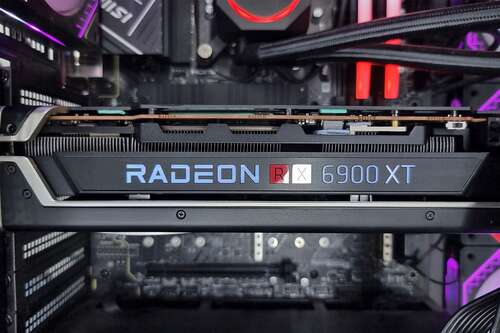
Key Takeaways
- AMD’s ray tracing performance is surprisingly close to Nvidia’s in the same performance segments.
- Some AMD cards outperform comparable Nvidia cards with ray tracing enabled. Such is the case with the RX 7800 XT and RTX 4070.
- AMD is expected to improve ray tracing performance in upcoming RDNA generations.
AMD started working on ray tracing with RDNA 2, the tech that powers the Xbox Series X/S, PlayStation 5, and RX 6000 Series graphics cards. Yet, the word on the street is that Nvidia is still the king of ray tracing… or is it?
How Do AMD Graphics Cards Handle Ray Tracing vs. Nvidia?
Nvidia has put a lot of focus on ray tracing over the past few years, starting with the 2018 launch of its RTX line of graphics cards with dedicated RT (Ray Tracing) Cores. AMD’s answer to the shots fired in the ray tracing wars arrived in 2020 with the launch of the RX 6000 series. AMD’s ray tracing enhancements are called Ray Accelerators, which are baked into the architecture and enhance the ray tracing performance of the standard compute units.
Nvidia’s dedicated cores tend to perform better in ray tracing, but they also result in an increased cost of graphics cards. While it’s generally true that Nvidia has better ray tracing performance than AMD, the question here is by how much and is it worth the premium pricetag?
Our first points of comparison are the high-end AMD RX 7900 XTX and the Nvidia RTX 4080 graphics cards. Hardware Unboxed pitted one against the other and found that the AMD card gets around 7–11% lower FPS, depending on the resolution, game, and whether or not upscaling is turned on. As a side note, the RX 7900 XTX was $200 cheaper at MSRP and slightly outperforms the RTX 4080 when ray tracing is off, so ray tracing remains Nvidia’s prime selling point and one of the justifications for the higher card cost.
On the higher end of the current GPU market, there’s a clear ray tracing edge for Nvidia. Does the performance comparison hold up with more budget-friendly but still current-generation cards? Prolific GPU reviewer Daniel Owen ran stress tests on the AMD RX 7600 vs the Nvidia RTX 4060. He found that the RTX 4060 outperforms the RX 7600 by around 10% with ray tracing off and around 20% with ray tracing enabled. Interestingly, the card is roughly 20% more expensive at MSRP, so opting for the RTX 4060 makes sense value-wise if you want ray tracing. If you don’t care about ray tracing, the slightly better RX 7600 XT might offer more value for you needs.
Perhaps the most interesting performance results are between the AMD RX 7800 XT and Nvidia RTX 4070. In another Hardware Unboxed GPU test, they found that the RX 7800 XT performs about the same as the RTX 4070 with ray tracing on and also beats it when it’s off. Mind you, the RTX 4070 is more expensive, both at MSRP and with current pricing. So, AMD beats Nvidia at their own game in the mid-range segment.
One of the main takeaways is that upscaling—namely DLSS and FSR—makes a massive difference when ray tracing is on. Upscaling can negate the performance hit that ray tracing brings to the table. Want to see it in action? Check out the following video by RandomGaminginHD, who played a few games with ray tracing thanks to FSR upscaling on the Ryzen 7 8700G APU without dedicated graphics:
Is AMD Planning to Improve Ray Tracing Performance?
AMD has worked hard to improve ray tracing performance over the past few years. As we’ve seen above, some of AMD’s cards already outperform Nvidia’s in ray tracing in their respective performance segments despite the lack of dedicated RT cores.
Still, the ray tracing performance is only going to get better. TechRadar suggests that RDNA 4—AMD’s upcoming generation of GPUs—will bring expected generational improvements in ray tracing performance, but we’ll have to wait until RDNA 5 for revolutionary ray tracing performance gains.
A PC Gamer report suggests that RDNA 4 could level the field by bringing AMD’s ray tracing performance to Nvidia’s level. It ultimately remains to be seen, but if the numbers above are anything to go by, the rumors could very well be true. AMD had a late start to the ray tracing game, but they’re making considerable strides in an effort to catch up.
Should You Even Care About Ray Tracing?
If you asked me about ray tracing three years ago, I would’ve laughed it off and said that it’s an Nvidia pipe dream. However, things have changed a lot with FSR 3 and DLSS 3 bringing frame generation to the equation. You can now get over playable FPS with high graphics settings and ray tracing enabled in many games, even on budget-oriented cards.
Ray tracing delivers highly realistic reflections, lighting, and shadows that you just can’t get otherwise. It brings games to life, especially when you pair it up with a quality HDR display. Games like Minecraft and Cyberpunk 2077 truly showcase the difference that ray tracing can make. Especially in a game like Minecraft where things are relatively “flat,” in terms of lighting effects and depth, turning on ray tracing feels like you’re upgrading to a completely new version of the game.
Ultimately, it’s up to you whether you want to enable ray tracing. My suggestion is to try your favorite games with ray tracing on and off; just make sure to enable DLSS/FSR as well to minimize the performance impact. And if your current card doesn’t support ray tracing? Well, no time like the present to upgrade your GPU.

